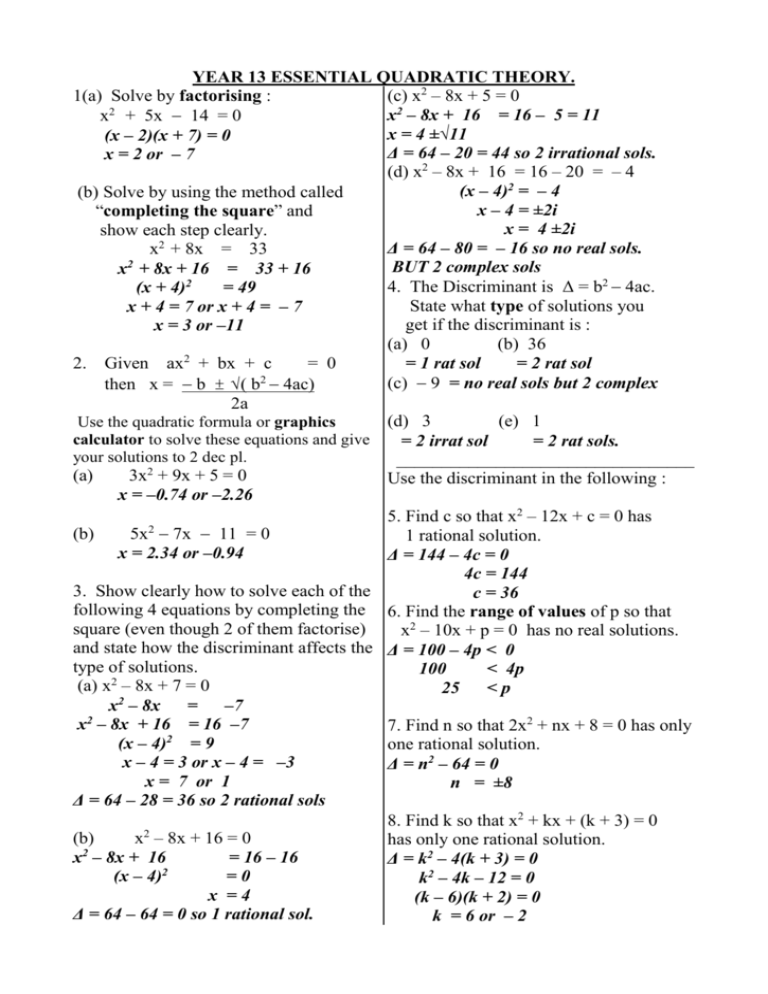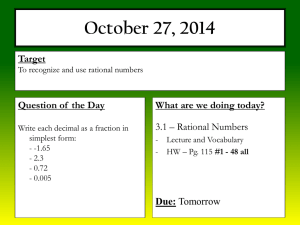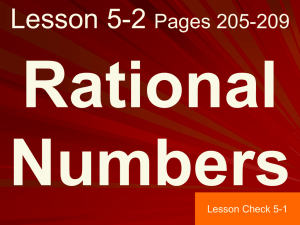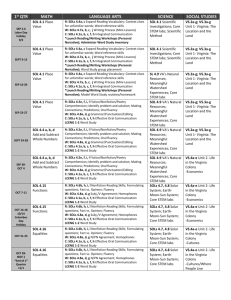Essential Quadratic Theory ANSWERS
advertisement

YEAR 13 ESSENTIAL QUADRATIC THEORY. 1(a) Solve by factorising : (c) x2 – 8x + 5 = 0 x2 – 8x + 16 = 16 – 5 = 11 x2 + 5x 14 = 0 x = 4 ±√11 (x – 2)(x + 7) = 0 Δ = 64 – 20 = 44 so 2 irrational sols. x = 2 or – 7 (d) x2 – 8x + 16 = 16 – 20 = – 4 (x – 4)2 = – 4 (b) Solve by using the method called x – 4 = ±2i “completing the square” and x = 4 ±2i show each step clearly. 2 Δ = 64 – 80 = – 16 so no real sols. x + 8x = 33 2 BUT 2 complex sols x + 8x + 16 = 33 + 16 2 4. The Discriminant is Δ = b2 4ac. (x + 4) = 49 State what type of solutions you x + 4 = 7 or x + 4 = – 7 get if the discriminant is : x = 3 or –11 (a) 0 (b) 36 2 2. Given ax + bx + c = 0 = 1 rat sol = 2 rat sol 2 (c) 9 = no real sols but 2 complex then x = b ± √( b 4ac) 2a (d) 3 (e) 1 Use the quadratic formula or graphics calculator to solve these equations and give = 2 irrat sol = 2 rat sols. your solutions to 2 dec pl. _________________________________ (a) 3x2 + 9x + 5 = 0 Use the discriminant in the following : x = –0.74 or –2.26 5. Find c so that x2 – 12x + c = 0 has 2 (b) 5x 7x 11 = 0 1 rational solution. x = 2.34 or –0.94 Δ = 144 – 4c = 0 4c = 144 3. Show clearly how to solve each of the c = 36 following 4 equations by completing the 6. Find the range of values of p so that square (even though 2 of them factorise) x2 – 10x + p = 0 has no real solutions. and state how the discriminant affects the Δ = 100 – 4p < 0 type of solutions. 100 < 4p 2 (a) x – 8x + 7 = 0 25 < p 2 x – 8x = –7 2 x – 8x + 16 = 16 –7 7. Find n so that 2x2 + nx + 8 = 0 has only (x – 4)2 = 9 one rational solution. x – 4 = 3 or x – 4 = –3 Δ = n2 – 64 = 0 x = 7 or 1 n = ±8 Δ = 64 – 28 = 36 so 2 rational sols 8. Find k so that x2 + kx + (k + 3) = 0 (b) x2 – 8x + 16 = 0 has only one rational solution. 2 x – 8x + 16 = 16 – 16 Δ = k2 – 4(k + 3) = 0 (x – 4)2 =0 k2 – 4k – 12 = 0 x =4 (k – 6)(k + 2) = 0 Δ = 64 – 64 = 0 so 1 rational sol. k = 6 or – 2 9. Find p so that x2 + (p+2)x + (3p –2) = 0 14. Find the range of values of p so that has only one rational solution. x2 + (p – 1)x + p + 2 = 0 has no real solutions. Δ = (p + 2)2 – 4(3p – 2) = 0 2 p + 4p + 4 – 12p + 8 = 0 Δ = (p – 1)2 – 4(p + 2) < 0 Y p2 – 8p + 12 = 0 p2 – 2p + 1 – 4p – 8 < 0 (p – 2)(p – 6) =0 p2 – 6p – 7 < 0 P = 2 or 6 (p – 7)(p + 1) < 0 10. Find d if x2 + (d+3)x + 3d + 1 = 0 has So – 1 < p < 7 only one rational solution. Δ = (d + 3)2 – 4(3d + 1) = 0 d2 + 6d + 9 – 12d – 4 = 0 15. Find k so that the equation d2 – 6d + 5 =0 x2 + 2(k – 2) x + (k2 – k – 5) = 0 (d – 1)(d – 5) =0 has only one rational solution. d = 1 or 5 Δ = 4(k – 2)2 – 4(k2 – k – 5) = 0 11. Find the range of values of K so that 4(k2 – 4k + 4) – 4k2 + 4k + 20 = 0 x2 – 8x + K = 0 has no real solutions. 4k2 – 16k + 16 – 4k2 + 4k + 20 = 0 Δ = 64 – 4K < 0 – 12k + 36 = 0 64 < 4k k=3 16 < k 16. Prove that the equation : x2 + bx + b2 = 0 can only have 12. Find the range of values of b so that unreal solutions for real values of b. x2 + bx + 9 = 0 has no real solutions. 2 Δ = b2 – 4b2 = – 3b2 Δ = b – 36 < 0 Since b2 is positive then – 3b2 must be b2 < 36 negative so the equation can only have b < +6 or b > – 6 unreal solutions. can be written as – 6 < b < 6 13. Find the range of values of n so that x2 +(n + 2)x + (n + 5) = 0 has 2 real solutions. Δ = (n + 2)2 – 4(n + 5) > 0 n2 + 4n + 4 – 4n – 20 > 0 n2 – 16 >0 2 n > 16 so n > 4 or n < – 4 17. Prove that the equation : ax(x + 1) = b(x + 1) has real roots for all real values of a and b. ax2 + ax = bx + b ax2 + (a – b)x – b = 0 Δ = (a – b)2 + 4ab = a2 – 2ab + b2 + 4ab = a2 + 2ab + b2 = (a + b)2 Since (a + b)2 must always be positive then the equation must always have real roots. p











